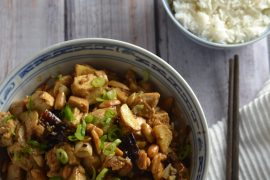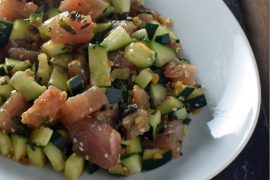A warm, steaming bowl of phở is the perfect comfort food on a winter’s day. Complex, aromatic broth ladled over a tangle of rice noodles and topped with fresh herbs, lime and chilies. A friend I served it to once aptly described it as “Grandma’s home cooking”. Not my grandma’s, or his, but surely someone’s.
Cooking phở is almost as delightful as eating it. The simmering broth makes your home smell amazing, filling the room with the warming scents of cinnamon, star anise, cloves and ginger; very comforting on a cold day. Although most of us might think of phở as a beef-based soup, the recipe below uses chicken, which is just as authentic.
Preparing phở can take about as long as you want. Some recipes recommend simmering the broth for three hours or longer. This recipe, which I learned from Richard Ruben at the Institute of Culinary Education, takes about 1 1/2 hours from start to finish, most of that time passive. Set the broth to simmer, relax for an hour while you enjoy the aromas, and you are almost done.
Top it with fresh cilantro, Thai basil or mint, chilies and lime and let the herbs wilt into the broth. The finished product should look rustic and busy. I prefer to eat it with chopsticks in my right hand and a deep spoon in my left, using the chopsticks to lift the noodles and the spoon to slurp down the broth. Enjoy it alone or paired with our Vietnamese summer rolls.
Phở Ga
Serves 6-8
| Spices and Other Aromatics for Pho |
1 (2-inch) cinnamon stick
4 whole star anise
4 whole cloves
2 teaspoons whole coriander seeds
2 stalks lemongrass, thinly sliced
1 (1-inch) piece ginger, thinly sliced
10 whole black peppercorns
3 kaffir lime leaves
4-6 cloves garlic, roughly chopped
2 quarts chicken stock
2 pounds bone-in, skinless chicken thighs
1/2 cup Vietnamese fish sauce
2 shallots, thinly sliced
3 scallions, thinly sliced
1 pound wide rice noodles (bahn phở)
Accompaniments: Thai basil or mint, cilantro, bean sprouts, thinly sliced red Thai chilies, lime wedges, hoisin sauce.
1. Heat a 4-quart pot over medium-high heat. Add the cinnamon, star anise, cloves, coriander, lemongrass, ginger, black peppercorns, lime leaves and garlic. Toast the ingredients for a few minutes, moving them around to avoid burning, until they become fragrant. Add the chicken stock and the chicken thighs. Bring the pot to a boil, reduce the flame to low, and simmer the soup, covered, for an hour.
| Bahn Pho Noodles |
2. Meanwhile, prepare the noodles according to the instructions on the package. Some rice noodles just require soaking in hot water. Others should be boiled for a few minutes. Whatever you do, make sure to taste them during the cooking process to ensure that they do not get too soft. They will soften further when added to the soup.
3. When the soup base has simmered long enough, strain it through a sieve set over a bowl, reserving the liquid. Remove the chicken from the sieve and shred the chicken meat from the bone. Clean out the pot and return the liquid and the shredded chicken back to it. Add the fish sauce, shallots and scallions. Bring the soup back to a boil.
4. Divide the noodles into bowls and ladle the hot broth over the top. Garnish each bowl with Thai basil or mint, cilantro leaves, bean sprouts, red chilies and lime wedges. Serve immediately with a small dish of hoisin sauce on the side.
I make a regular pilgrimage to Bangkok Center Grocery at 104 Mosco Street in Chinatown to obtain the ingredients for phở and other Southeast Asian recipes. Lemongrass, lime leaves and Thai chilies stay for months in the freezer, so I buy these in large quantities. Thai basil stays only a few days and is hard to find elsewhere (which is why it does not appear in the photos above). Note that Italian basil is not a good substitute. Fresh mint is closer and will do in a pinch. I don’t like bean sprouts, so I leave them out.
For more information where to obtain the ingredients for phở and other Asian recipes, please see our guide to Food Shopping in Chinatown.





You better invite me over the next time you make pho!